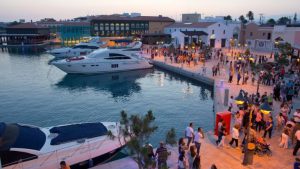
Limassol, the second-largest city in Cyprus and southern Europe, is known for its vibrant nightlife, rich cultural traditions, and bustling port. The city has experienced significant growth, particularly after the Turkish invasion in 1974, which led to the loss of another important port in Cyprus, Famagusta.
Although Limassol is a relatively new city, archaeological findings indicate that the area has been inhabited since ancient times. It is situated in the southern part of Cyprus, built amphitheatrically on Akrotiri Bay, between the ancient cities of Amathus to the east and Kourion to the west. The city’s development began with the presence of British military bases in the west, and it has expanded eastward, offering sandy beaches along the coastline.
Limassol first emerged in history during the early Byzantine era under the name Neapolis. It was a bishopric and was referred to as Theodosia (or Theodosianus) and New City (Neapolis). It thrived between the two important ancient cities of Amathus and Kourion. Today, Amathus is known as the Old City. Limassol played a significant role during the medieval period, hosting the wedding of Richard the Lionheart and Berengaria, who was later crowned the queen of England. The coronation also took place in Limassol. The Crusaders established their headquarters in the west of Limassol, now known as Kolossi Medieval Castle. This period also marked the beginning of wine production on the island, particularly the production of sweet wine, Commandaria, which holds the distinction of being the world’s oldest named wine.
In 1191, Limassol witnessed the arrival of King Richard the Lionheart, who conquered Cyprus with his troops. In 1291, the town was given to the Templars and Hospitallers by the Frankish King of Cyprus, Henry II. However, the Knights later conquered Rhodes and transferred their headquarters there, while the Order of Templars was dissolved by the pope’s decision. In 1426, the city was captured and plundered by the Saracens, and it occasionally faced attacks from various invaders.
Among the preserved monuments in Limassol is the medieval fortress, believed to have been built in the 12th or early 13th century. Contrary to popular belief, the fort was not the site of Richard the Lionheart’s wedding to Berengaria of Navarre, as it had not yet been constructed in 1191 when the wedding took place. Instead, sources indicate that the marriage ceremony was held in the small church of St. George, which no longer exists.
Limassol has expanded beyond its municipal boundaries, with the oldest part preserved as the Historical Center, stretching from the streets near the Old Port to the eastern length of the beach. The focal point of the historical center is Limassol Castle, a prominent landmark in the city. It is believed that Richard the Lionheart married in the castle’s chapel. Today, the castle houses the Cyprus Medieval Museum, showcasing exhibits from across Cyprus. The surrounding area is pedestrianized and features numerous restaurants, bars, and showrooms, making it the cultural and nightlife hub of Limassol. To the east of the castle stands the Cathedral of Agia Napa, built in the late 19th century.


